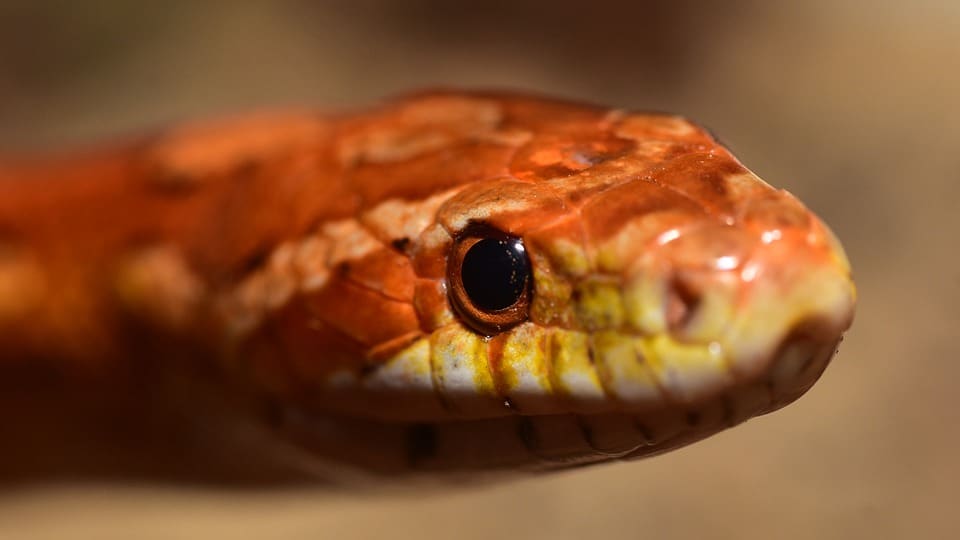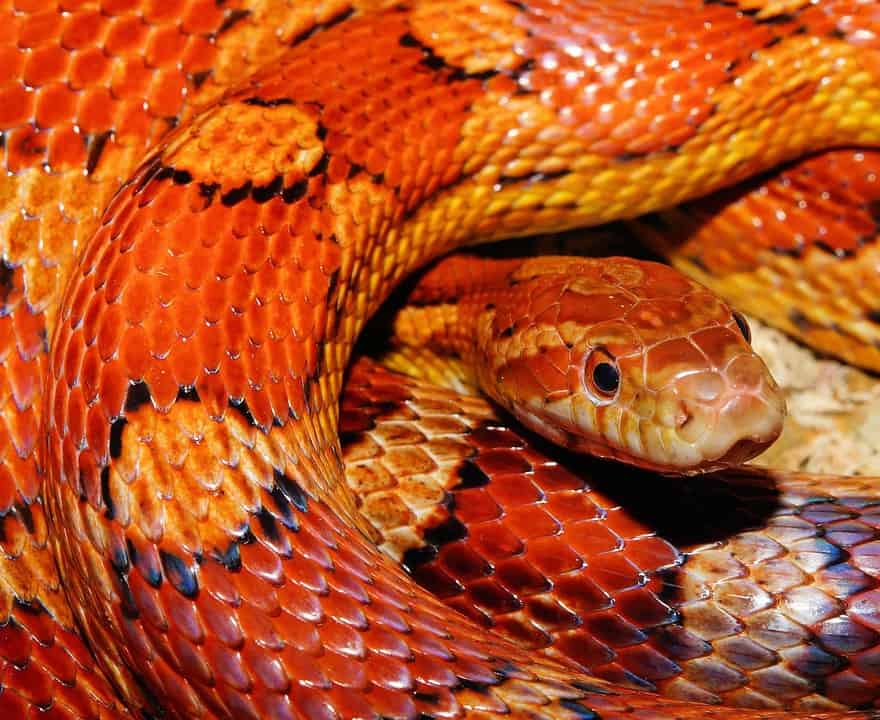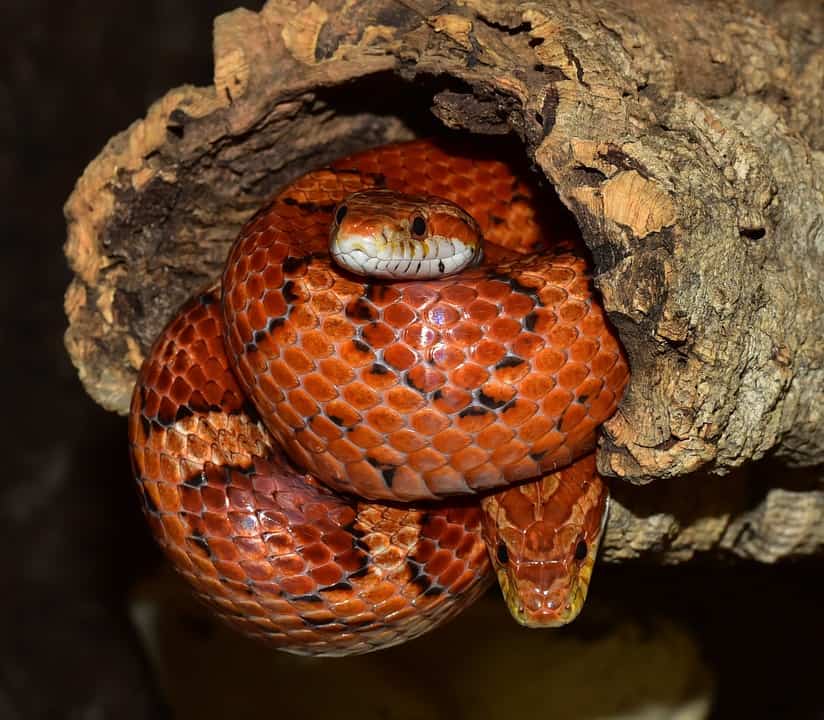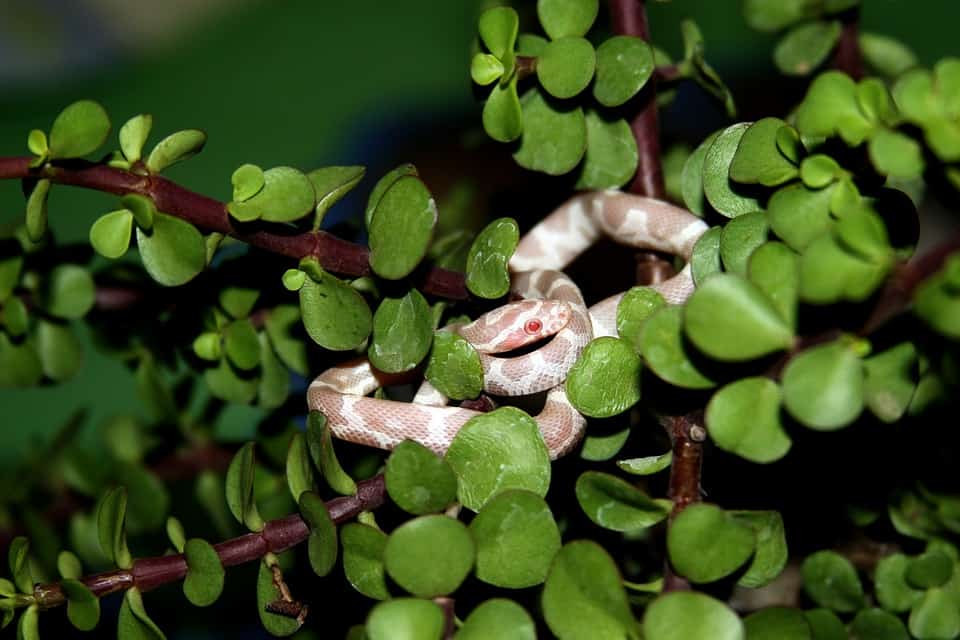Corn snakes were either named for their tendency to hang out in cornfields (where rodents are abundant), or for the maize-like pattern on their ventral surfaces. However, as members of the genus Pantherophis, they’re occasionally called red rat snakes too (this isn’t as common as it was a few decades ago).
In many ways, red rat snake is a better moniker for these snakes, as it not only describes their colors, it also illustrates one of their preferred food items. Rats aren’t the only thing corn snakes eat, but they’re certainly one of their most important food sources.
And because commercial rodents are some of the most convenient food sources for snakes, corn snakes are usually pretty easy to feed.
Corn Snake Feeding Chart
We’ve put together a quick-reference feeding chart below to help you understand the proper prey size and feeding schedule for corn snakes of various ages and sizes.
Just note that all snakes are individuals, so you’ll need to adjust the recommendations in this chart to suit your specific snake. Some corn snakes grow faster or slower than others, while some simply prefer larger or smaller prey items than other corn snakes.
In all cases, you’ll want to tailor the size of the prey offered (as well as the feeding schedule employed) to suit your individual snake’s needs. As a rule of thumb, you’ll want to provide your snake with a food item that is about 1.25 times the size of your snake at midbody. Food items should create a modest, yet obvious bulge in your snake’s body.
Nevertheless, the chart below should provide a good starting point.
| Snake Age | Snake Size | Prey Type | Feeding Schedule |
| Less than 6 months | Less than 25 grams | Pinky or fuzzy mouse | Every 5 to 7 days |
| 6 to 12 months | 25 to 100 grams | Hopper or small adult mouse | Every 5 to 7 days |
| 1 to 2 years old | 100 to 400 grams | Large mouse or rat hopper | Every 7 days |
| 2 to 4 years old | 400 to 700 grams | Large mice (multiple) or a small rat | Every 7 to 10 days |
| More than 4 years old | More than 700 grams | Large mice (multiple) or a small rat | Every 7 to 14 days |
>Further Reading: Corn Snake Care Sheet: A Simple (But Complete) Guide for Beginners
Corn Snake Feeding: What Do They Eat?
Wild corn snakes eat a variety of prey species in the wild. Some of the most commonly consumed prey items include:
- Rodents (including voles, mice, rats, chipmunks and squirrels)
- Birds (and their eggs)
- Frogs
- Lizards
As a general rule, lizards and frogs are the most important food sources for hatchling and juvenile corn snakes in the wild, while rodents and birds become the most important food sources for adult corn snakes.
In captivity, the vast majority of keepers feed their corn snake commercially reared, frozen-thawed rodents. However, a small subset of keepers prefer to feed commercially produced birds.
Why Won’t My Corn Snake Eat?
Although corn snakes are typically enthusiastic eaters, most snakes will refuse food on occasion.
The refusal of a meal or two is absolutely no cause for concern. Simply dispose of the thawed rodent and offer a fresh rodent at the next scheduled feeding.
If your snake continues to refuse food for several weeks, you’ll need to figure out what the problem is and take steps to rectify it.
Some of the most common reasons corn snakes refuse food include:
- Snakes often refuse food when they’re entering a shed cycle
- Adult corn snakes may refuse food entirely during the winter
- Adult males often refuse food during the breeding season
- Female corn snakes may refuse food if they are gravid
None of these reasons should cause you to worry, as they’ll resolve themselves over time. However, there are also a few reasons corn snakes will refuse food that will require your attention.
Hatchling Corn Snakes May Prefer Lizards or Frogs
In some cases, hatchling corn snakes prefer lizards or frogs, causing them to refuse the rodents offered by their keepers. In such cases, it is often possible to “trick” the corn snakes into eating pinky (hairless, newborn mice) or fuzzy mice (slightly furred, non-weaned mice) by rubbing a frog or lizard on the rodent before offering it to your snake.
This is called “scent transferring” and it works because snakes largely (although not exclusively) recognize prey via scent, rather than sight. Typically, scent transferring is only necessary for a few weeks, after which most picky corn snakes will begin to accept unscented rodents.
Habitat Problems Can Cause Corn Snakes to Refuse Food
If your corn snake’s habitat is not properly designed and maintained, your corn snake may refuse to eat. The most common habitat problem to cause food refusal is sub-optimal temperatures. So, always check your pet’s habitat temperatures if he refuses food. The temperatures under the basking spot should be about 90 degrees Fahrenheit, while the cool side of the enclosure should ideally be in the low- to mid-70s.
Additionally, it is important to make sure your corn snake has at least one hiding spot, and that you are using a suitable substrate. It can also be helpful to provide climbing branches, which often help make corn snakes feel more comfortable.
Stress Can Cause Corn Snakes to Refuse Food
Snakes – like many other animals – often lose their appetites when experiencing high stress levels. Obviously, snakes don’t become stressed because they have to sit in traffic, pay bills, or work a 9 to 5 job – instead, they become stressed because they do not feel safe or do not have a proper habitat.
So, be sure that your snake’s habitat is properly designed (we discuss corn snake habitats in more detail here) and features at least one hiding space. Additionally, be sure that you are not handling your snake too frequently, as this can also cause stress. It’s also important to make sure cats, dogs and other household pets aren’t stressing your snake out by staring into the enclosure incessantly.
Illness Can Cause Corn Snakes to Refuse Food
The most troubling reason a corn snake will refuse food is illness. A variety of ailments can cause a corn snake to lose his appetite, but a few of the most common include the following:
- Respiratory infections
- Gastrointestinal infections
- Internal parasites
- External parasites
- Reproductive problems
You’ll need your veterinarian’s help to diagnose and treat these illnesses. So, be sure to take your snake in for an examination if he refuses food for several weeks and you can’t identify a habitat- or stress-related reason for the problem.
How Long Can a Corn Snake Go Without Eating?
Snakes aren’t like mammals and birds, who must eat regularly to remain healthy. In fact, snakes routinely go several weeks (and in some cases months) between meals. So, food refusal is rarely an immediate concern – you’ll usually have plenty of time to figure out how to fix the issue.
Nevertheless, snakes obviously can’t go forever without eating. The question is, how long is too long?
It is difficult to make blanket generalizations about the length of time snakes can go without eating. A snake’s age, health, and fat reserves are all factors which must be considered. However, as a general rule of thumb, it is generally not necessary to worry about your snake until he has refused food for more than one month.
Hatchling and juvenile corn snakes who refuse food for more than one month may begin to lose weight or languish, so you’ll definitely want to seek the help of a veterinarian or experienced keeper in such cases. Healthy adults aren’t likely to lose much weight or fall ill from fasting for a month (it would likely take 6 months or more of missed meals to starve a healthy adult corn snake), but it is still wise for beginners to seek guidance in these situations.
How to Feed a Baby Corn Snake?
You can feed corn snakes of all ages in essentially the same way. However, hatchling corn snakes are often a bit trickier to feed than adults, thanks to the small size of their prey and the tendency for hatchling snakes to be more nervous than adults.
Start by thawing a small pinky or fuzzy mouse (do not use a microwave to do so – just place the mouse in a refrigerator until it thaws completely). Then, grasp the rodent with a pair of tweezers or forceps. Move the rodent in front of your snake’s face slowly and watch for the snake to begin flicking his tongue.
In most cases, the snake will begin moving toward the rodent slowly, and then he’ll strike out quickly, and begin constricting the prey item (even though the rodent is already dead, most corn snakes will instinctually constrict it). Release the rodent once your snake begins coiling around it, and then slowly back away so your snake can eat in peace.
In some cases, it may be necessary to “animate” the rodent to make it appear alive. You can do so by simply wiggling it a little bit in front of the snake. This often takes practice, as you’ll need to learn how much movement is sufficient to elicit the snake’s attention, without moving it so much that it startles or intimidates your snake.
Corn Snakes Are Usually Problem-Free Feeders
Feeding your new corn snake is often one of the most fun aspects of snake maintenance, and many keepers thoroughly enjoy it. Fortunately, corn snakes are typically eager eaters, who don’t present many feeding problems. Just be sure that you follow the recommendations discussed above and seek help if you run into problems.
In most cases, you should be able to keep your corn snake well-fed and health without much trouble.










8 Comments
this was very helpful im planning on getting a corn snake for my 17th and thanks to all this help the start of my journey will be a lot less stressful thanks so much
Can I feed an adult corn snake multiple pinkys? If so, how many?
Hi Eva,
Yes, adult corn snakes can eat multiple pinkys. However, to maintain the snake’s health and weight, it is best to provide them with 2-3 pinkys per week. Depending on the size of your snake and its age, you may be able to give more than 3 pinkys if necessary.
It is important to monitor your snake’s weight and adjust the number of pinkys accordingly. If you offer too many, it can lead to obesity which is unhealthy for your snake.
Good luck!
Please note that the link at the bottom of the page:
> Further Reading: Corn Snake Care Sheet: A Simple (But Complete) Guide for Beginners
leads to “Sorry, you are not allowed to preview drafts.” page.
Carissa
Hi Carissa,
Thank you for letting me know, I’ll get this fixed asap.
Hi Sam! I wanted to let you know that this error is still happening.
My daughter (9 yo) is begging for a corn snake. Thank you for all of this information!
-Sarah
Hi Sarah! Thanks for letting us know. I updated the link 🙂
I’ve taken care of many reptiles in the past but not for a few years now. My daughter asked for one as well. They are for sure a best bet for beginners. Easy to handle and feed but she should leave it to digest the food the next day in peace no handling. Let her have fun creating its enclosure. We love this part. I’ve also learned it’s ok to keep two females together if you start when they are small but not to do so with a male and female because they will become competitive with food and space.